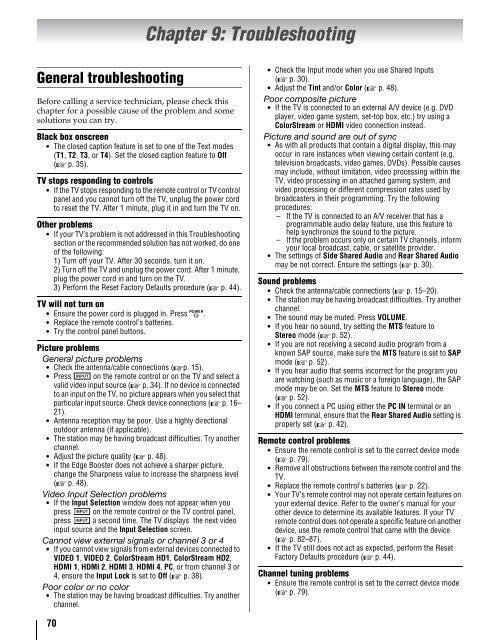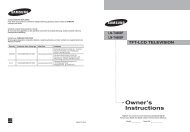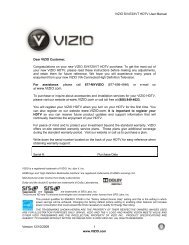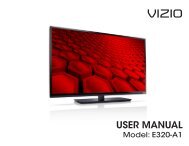Create successful ePaper yourself
Turn your PDF publications into a flip-book with our unique Google optimized e-Paper software.
Chapter 9: Troubleshooting<br />
General troubleshooting<br />
Before calling a service technician, please check this<br />
chapter for a possible cause of the problem and some<br />
solutions you can try.<br />
Black box onscreen<br />
• The closed caption feature is set to one of the Text modes<br />
(T1, T2, T3, or T4). Set the closed caption feature to Off<br />
(- p. 35).<br />
TV stops responding to controls<br />
• If the TV stops responding to the remote control or TV control<br />
panel and you cannot turn off the TV, unplug the power cord<br />
to reset the TV. After 1 minute, plug it in and turn the TV on.<br />
Other problems<br />
• If your TV’s problem is not addressed in this Troubleshooting<br />
section or the recommended solution has not worked, do one<br />
of the following:<br />
1) Turn off your TV. After 30 seconds, turn it on.<br />
2) Turn off the TV and unplug the power cord. After 1 minute,<br />
plug the power cord in and turn on the TV.<br />
3) Perform the Reset Factory Defaults procedure (- p. 44).<br />
TV will not turn on<br />
• Ensure the power cord is plugged in. Press p.<br />
• Replace the remote control’s batteries.<br />
• Try the control panel buttons.<br />
Picture problems<br />
General picture problems<br />
• Check the antenna/cable connections (-p. 15).<br />
• Press INPUT on the remote control or on the TV and select a<br />
valid video input source (- p. 34). If no device is connected<br />
to an input on the TV, no picture appears when you select that<br />
particular input source. Check device connections (- p. 16–<br />
21).<br />
• Antenna reception may be poor. Use a highly directional<br />
outdoor antenna (if applicable).<br />
• The station may be having broadcast difficulties. Try another<br />
channel.<br />
• Adjust the picture quality (- p. 48).<br />
• If the Edge Booster does not achieve a sharper picture,<br />
change the Sharpness value to increase the sharpness level<br />
(- p. 48).<br />
Video Input Selection problems<br />
• If the Input Selection window does not appear when you<br />
press INPUT on the remote control or the TV control panel,<br />
press INPUT a second time. The TV displays the next video<br />
input source and the Input Selection screen.<br />
Cannot view external signals or channel 3 or 4<br />
• If you cannot view signals from external devices connected to<br />
VIDEO 1, VIDEO 2, ColorStream HD1, ColorStream HD2,<br />
HDMI 1, HDMI 2, HDMI 3, HDMI 4, PC, or from channel 3 or<br />
4, ensure the Input Lock is set to Off (- p. 38).<br />
Poor color or no color<br />
• The station may be having broadcast difficulties. Try another<br />
channel.<br />
• Check the Input mode when you use Shared Inputs<br />
(- p. 30).<br />
• Adjust the Tint and/or Color (- p. 48).<br />
Poor composite picture<br />
• If the TV is connected to an external A/V device (e.g. DVD<br />
player, video game system, set-top box, etc.) try using a<br />
ColorStream or HDMI video connection instead.<br />
Picture and sound are out of sync<br />
• As with all products that contain a digital display, this may<br />
occur in rare instances when viewing certain content (e.g.<br />
television broadcasts, video games, DVDs). Possible causes<br />
may include, without limitation, video processing within the<br />
TV, video processing in an attached gaming system, and<br />
video processing or different compression rates used by<br />
broadcasters in their programming. Try the following<br />
procedures:<br />
– If the TV is connected to an A/V receiver that has a<br />
programmable audio delay feature, use this feature to<br />
help synchronize the sound to the picture.<br />
– If the problem occurs only on certain TV channels, inform<br />
your local broadcast, cable, or satellite provider.<br />
• The settings of Side Shared Audio and Rear Shared Audio<br />
may be not correct. Ensure the settings (- p. 30).<br />
Sound problems<br />
• Check the antenna/cable connections (- p. 15–20).<br />
• The station may be having broadcast difficulties. Try another<br />
channel.<br />
• The sound may be muted. Press VOLUME.<br />
• If you hear no sound, try setting the MTS feature to<br />
Stereo mode (- p. 52).<br />
• If you are not receiving a second audio program from a<br />
known SAP source, make sure the MTS feature is set to SAP<br />
mode (- p. 52).<br />
• If you hear audio that seems incorrect for the program you<br />
are watching (such as music or a foreign language), the SAP<br />
mode may be on. Set the MTS feature to Stereo mode<br />
(- p. 52).<br />
• If you connect a PC using either the PC IN terminal or an<br />
HDMI terminal, ensure that the Rear Shared Audio setting is<br />
properly set (- p. 42).<br />
Remote control problems<br />
• Ensure the remote control is set to the correct device mode<br />
(- p. 79).<br />
• Remove all obstructions between the remote control and the<br />
TV.<br />
• Replace the remote control’s batteries (- p. 22).<br />
• Your TV’s remote control may not operate certain features on<br />
your external device. Refer to the owner’s manual for your<br />
other device to determine its available features. If your TV<br />
remote control does not operate a specific feature on another<br />
device, use the remote control that came with the device<br />
(- p. 82–87).<br />
• If the TV still does not act as expected, perform the Reset<br />
Factory Defaults procedure (- p. 44).<br />
Channel tuning problems<br />
• Ensure the remote control is set to the correct device mode<br />
(- p. 79).<br />
70
















